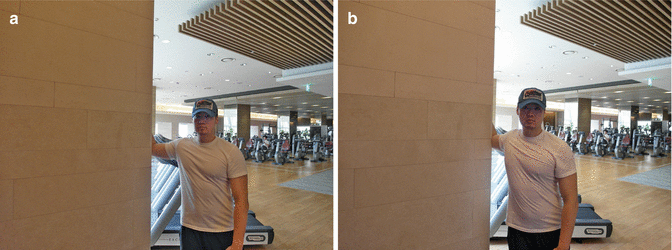Fig. 32.1
Lower trapezius
32.1.1 Functions
1.
Scapular depression and adduction
2.
Extension of the thoracic vertebra
3.
Most important role for shoulder function and posture maintenance
Origin:
External occipital protuberance
Medial 1/3 of the superior nuchal line of the occipital bone
Ligamentum nuchae
Spinous process of the 7th cervical spine
Spinous process of all thoracic spines
Corresponding supraspinal ligament insertions
Insertion:
Medial end of the scapular spine
Tubercle at the apex of the scapular surface
32.1.2 Rehabilitation Exercise
32.1.2.1 Latissimus Pull Down
Method of exercise:

2.
Pull down the bar to your shoulder level while you are breathing out (have a feeling that you are pulling down with your shoulder) (Fig. 32.2b).
3.
If you hold the bar with an undergrip or lean backward while pulling the bar, more stimuli will be done on the lower trapezius.

Fig. 32.2
Latissimus pull down
32.1.2.2 Posterior Fly
Method of exercise:

2.
With your elbows extended and thumbs pointing upward, lift up your arms to your shoulder level (Fig. 32.3b).
3.
When dropping your arm, give resistance to the upper portion of your elbows.

Fig. 32.3
Posterior fly
32.1.2.3 Modified Prone Cobra
Method of exercise:
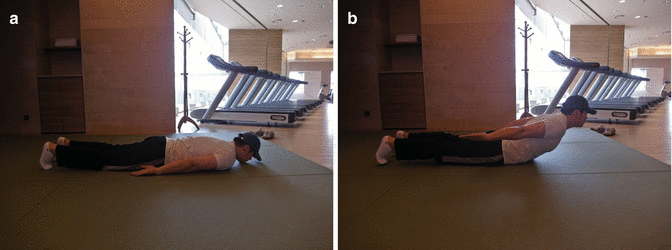
3.
Both palms should face away from your body and thumbs pointing upwards.
4.
Pull both your scapulae to maintain a finger width between the medial borders of the scapulae.
5.
When returning to initial position, keep your palm facing upward and give resistance.

Fig. 32.4
Modified prone cobra
32.1.2.4 Prone V-Raise
Method of exercise:

2.
Make your shoulders 180° and abduct 120° with your elbow slightly flexed.
3.
With your thumb pointing upward, lift up your arms to the ear level by pulling shoulder and concentrate your scapula together (Fig. 32.5b).
4.
While returning to your initial position, keep your arm position, and when the trainer is giving help, give resistance above the elbows only.
5.
You can use a dumbbell if you have done sufficient exercise with your bare hands.

Fig. 32.5
Prone V-Raise
32.2 Middle Trapezius
32.2.1 Function
1.
Function: scapular retraction, adduction, and upward rotation
2.
Origin:
External occipital protuberance
Medial 1/3 of the superior nuchal line of the occipital bone
Ligamentum nuchae
Spinous process of the 7th cervical spine
Spinous process of all thoracic spines
Corresponding supraspinal ligament insertions
3.
Insertion:
Medial margin of the acromion
Superior lip of the posterior border of the spine of the scapula
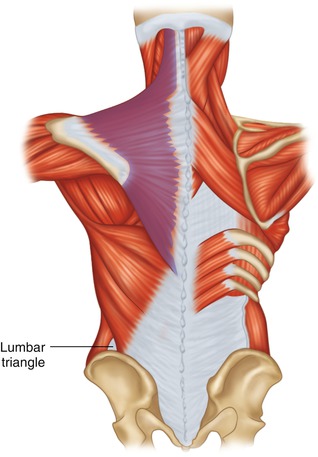
Fig. 32.6
Upper trapezius (please point the upper side or trapezius muscle)
32.2.2 Rehabilitation Exercise
32.2.2.1 Seated Cable Row
1.
2.
Return to the starting position maintaining your upper back muscle tension.
3.
When exercising be careful not to bounce on your upper body and try not to load pressure on your lower back by straightening it. When returning, try not to flex your lower back.
4.
Maximally squeezing your upper back muscle, pull up the dumbbells with the elbows brushing your body with keeping head up.
5.
A bar in front to prevent hyperflexion of the spine (kyphosis) makes it more effective to those with back pain and old age.

Fig. 32.7
Seated cable row
32.2.2.2 Bent-Over Dumbbell Row
1.
Stand on your shoulder width, draw back hips together, and with straight back bend over 40–50° (Fig. 32.8a).
2.
Maximally squeezing your upper back muscle, pull up the dumbbells with the elbows brushing your body with keeping head up (Fig. 32.8b).
3.
It is effective to maximally contract your upper back muscle. Try not to spread your shoulders.
4.
Bending too much can load pressure on your lower back. So do not bend over exceeding your comfort.

Fig. 32.8
Bent-over dumbbell row
32.2.2.3 Band Rowing
1.
2.
Make sure not to injure your lower back, do not move your back too much (keep it straight). Keep in mind that this exercise is not for your lower back but for your upper back.

Fig. 32.9
Band rowing
32.2.2.4 Reverse Dumbbell Fly
1.
This exercise is for the posterior deltoid, but it can also help the trapezius.
2.
Try to concentrate on maximally contracting the upper back muscle, not the deltoid.

Fig. 32.10
Reverse dumbbell fly
32.3 Upper Trapezius
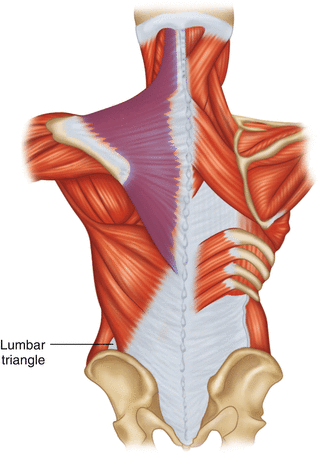
Fig. 32.11
Upper trapezius
32.3.1 Function
1.
Elevation and extension of the shoulder
2.
Origin:
External occipital protuberance
Medial 1/3 of the superior nuchal line of the occipital bone
Ligamentum nuchae
Spinous process of the 7th cervical spine
Spinous process of all thoracic spines
Corresponding supraspinal ligament insertions
3.
Insertion:
Posterior border of the lateral 1/3 of the clavicle
32.3.2 Rehabilitation Exercise
32.3.2.1 Band Shoulder Shrug
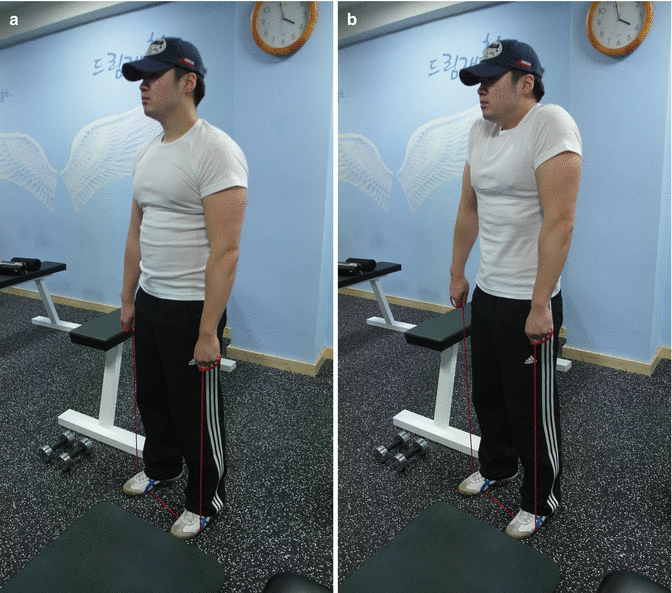
Fig. 32.12
Band shoulder shrug
3.
Do not bounce on your lower back or legs.
4.
Breathe in when shrugging up, breathe out when you are returning to initial position.
32.3.2.2 Barbell Shrug

Fig. 32.13
Barbell shrug
1.
This exercise is well known for upper trapezius muscle exercise. Stand on your shoulder width with your knees flexed slightly and your back straight (Fig. 32.13a).
2.
Hold the barbell with your shoulder width and shrug as much as you can by contracting the trapezius muscle. Pause for a bit then slowly come back to the initial position (Fig. 32.13b).
3.
The barbell can also be held from your back.
4.
Breathe in when shrugging up, breathe out when returning to the initial position.
5.
Holding the barbell from your back can limit your lower back bending too much (kyphosis) but could be dangerous to your posture. So try with a light weight.
32.3.2.3 Dumbbell Upright Row
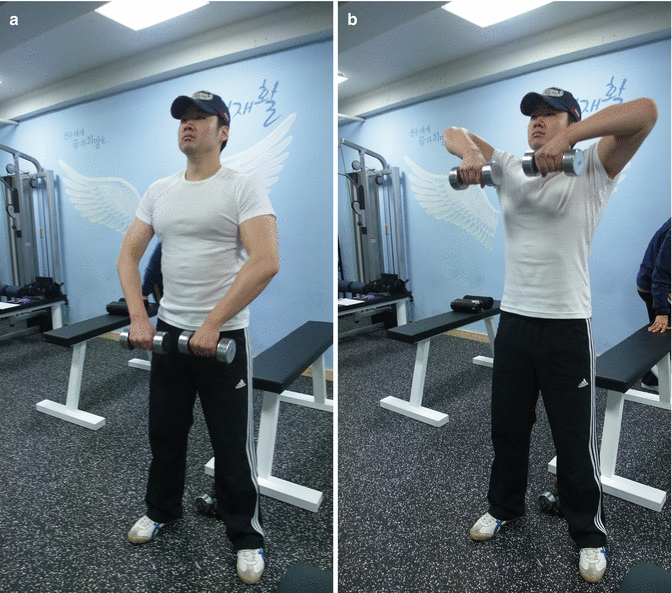
Fig. 32.14
Dumbbell upright row
2.
Lift the dumbbells just below your chin, make sure both elbows are above your hands (Fig. 32.14b).
3.
Stay still for a while maintaining tension on your trapezius. Breathe in and lower the dumbbells beside your body.
4.
It stimulates trapezius muscles more in narrower grip, as opposed to the deltoids.
32.3.2.4 Barbell Upright Row

Fig. 32.15
Barbell upright row
1.
Holding the barbell with a short length between the hands develops the trapezius muscle, and broad length between the hands develops the deltoid muscle.
32.4 Serratus Anterior
Serratus anterior is not a big muscle, but it is very important for maintaining stabilization of the scapula. Under innervation of the long thoracic nerve, this muscle originates from the first to the ninth (or tenth) rib and inserts on the medial border of the scapula. It consists of serratus anterior superior, serratus anterior intermediate, and the serratus anterior inferior. All three parts pull the scapula toward the thorax. To restate it, these muscles act together to hold the scapula in the right place.
The lower portion externally rotates and pulls forward the lower part of the scapula. This makes lifting of your arm possible. The upper portion elevates the scapula.
The serratus anterior plays a major role in scapula protraction, and this action is important in throwing or arm swinging (boxer’s muscle).
The serratus anterior stabilizes the scapula on the rib cage against the forward loading, and if the muscle does not act right, scapula winging occurs. If the scapula is not in the right place, it causes pain during ROM exercise. It also causes impingement syndrome or tear of the rotator cuff. For athletes, it causes GIRD and many other problems. Especially for baseball or volleyball players who do the throwing motion too much, weakened muscles around the scapula including the serratus anterior cause major decline for exercise capacity.
Rehabilitation must be preceded to treat the weakened serratus anterior, and many of the cases improved from rehabilitation. Before starting the treatment flexibility of the joint should be retained. Secure flexibility to those with GIRD by sleeper stretch and those with coracoid inflexibility with open book stretch.
Origin:
Outer surface and superior border of the first 8 or 9 ribs
Aponeuroses covering the intervening intercostal muscle
Insertion:
Ventral surface of the medial border of the scapula
32.4.1 Push-up Plus or Wall Push-up
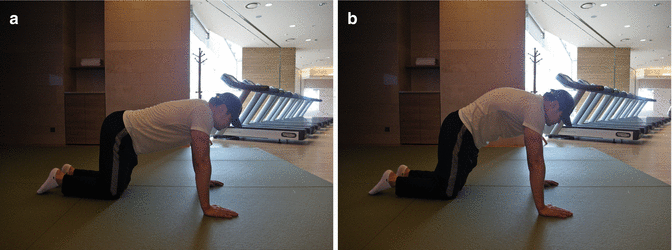
Fig. 32.16
Push-up plus or wall push-up
This is the main exercise. This exercise is a usual push-up including scapula protraction. It can be done on several postures and also can be done standing with your hands leaning on the wall (Fig. 32.16a). Width between your hands and height of your hands affect different parts of the muscle. Slowly exercise and unlike the usual push-up, do not use your elbow but use your scapula (Fig. 32.16b). If you don’t have sufficient muscle power, exercise against the wall or knees and elbows on the floor. Once you retain your muscle power, exercise like the usual push-up with knees not touching the floor.
32.4.2 Pull Over

Fig. 32.17
Pull over
This exercise is for the anterior chest muscles but also has great effect for the serratus anterior. Start with not too much weight before retaining muscle power. The key point is to protract your scapula while lifting up the dumbbell.
32.4.3 Dumbbell Scapula Protraction
Exercise can be done on either one hand or both hands. Dumbbell weight can be controlled depending on your muscle power. This exercise is adequate for an initial state without sufficient muscle power.
32.5 Latissimus Dorsi
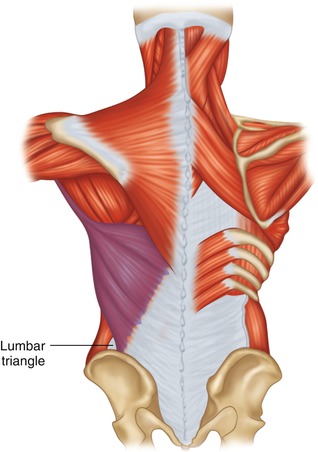
Fig. 32.19
Latissimus dorsi
32.5.1 Functions
1.
Adduction, extension, and internal rotation of the shoulder
2.
Partly acts as a scapula stabilizer
3.
Origin:
Aponeurotic origin:
Spinous processes of the lower 6 thoracic and all lumbar and sacral vertebrae
Supraspinous ligament
Posterior part of the crest of the ilium
Muscular origin:
Muscular fasciculi from the external lip of the crest of ilium
Caudal 3–4 ribs
Inferior pole of the scapula
Insertion:
Distal part of the intertubercular groove of the humerus
32.5.2 Rehabilitation Exercise
32.5.2.1 Lateral Pull Down
1.
Sit in front of the instrument and hold the bar just wider than your shoulder width (Fig. 32.20a).
2.
Breathe in while pulling the bar to your shoulder level with a feeling of using the shoulders (Fig. 32.20b).
3.
It is important to make your back straight, and it is more effective when elbows are behind your back.
4.
Spreading your shoulders can give more stimulation.

Fig. 32.20
Lateral pull down
32.5.2.2 Bent-Over Dumbbell Row
1.
Spread your legs as wide as your shoulder width, and with knees flexed slightly, and take care of your back keeping straight (Fig. 32.21a).
2.
Breathe out while pulling the dumbbells to the lower abdomen or pelvis by bending your elbows (Fig. 32.21b).
3.
Slowly return with resistance.
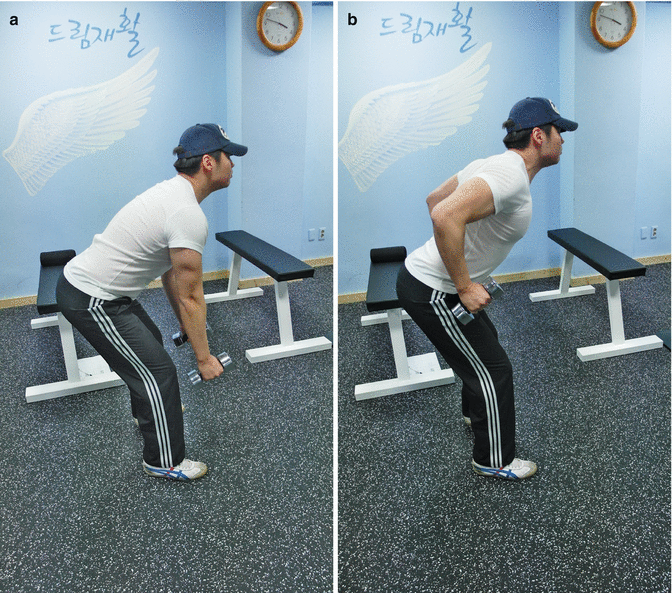
Fig. 32.21
Bent-over dumbbell row
32.6 Pectoralis Minor Muscle Exercise
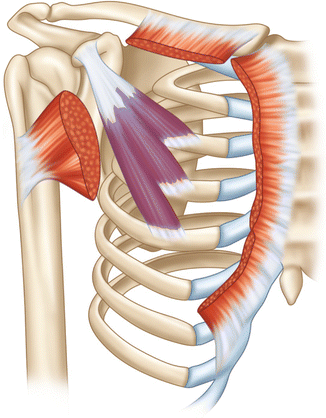
Fig. 32.23
Pectoralis minor
32.6.1 Anatomy
1.
Origin:
Clavicular part:
Anterior surface of the sternal 1/2 of the clavicle
Sternocostal parts
1/2 the breadth of the anterior surface of the sternum (cartilages of the 6th/7th ribs)
Cartilages of all the true ribs
Abdominal parts:
Aponeurosis of the external abdominal oblique muscle
2.
Insertion:
Muscle rotates before its insertion
Lower end of the lateral lip of the intertubercular sulcus of the humerus (3 laminae)
Anterior part: clavicular part
Middle part: upper sternocostal part
Posterior part: lower sternocostal part and abdominal part
32.6.2 Function
1.
Scapula protraction – Moving the scapula forward
2.
Scapula depression – Moving the scapula downward
3.
Scapula downward rotation – lowering and rotating the inferior angle of the scapula medially
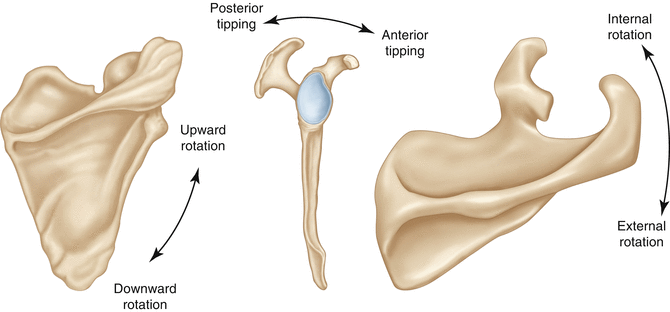
Fig. 32.24
Scapula function
32.6.3 Explanation
This muscle elongates during arm elevation, upward rotation of the scapula, external rotation, and retraction of the scapula.
Also this muscle is the cause of bench-pressers shoulder when the exercise is not done in the right position or done too much.
32.6.4 Rehabilitation Exercise
32.6.4.1 Unilateral Corner Stretch
32.6.4.2 Sitting Manual Stretch
1.
Sit on a stool with your back straight.
2.
Breathe in deeply.
3.
The trainer should hold the inferior border of the scapula and push back the coracoid process of the scapula with the opposite hand.
4.
Maintain for 3 s and after stretching, breathe out.
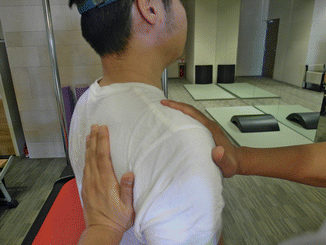
Fig. 32.26
Sitting manual stretch
32.6.4.3 Supine Manual Stretch
1.
Start with lying down.
2.
Use a therapeutic bed or place a towel under your thoracic spine to slightly lift your scapula.
3.
The trainer should flex the elbow 90° and abduct the shoulder 90°.
4.
Then stretching is done by pushing the coracoid process of the scapula for 3 s.
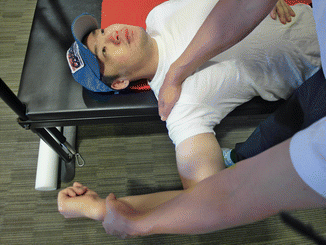
Fig. 32.27
Supine manual stretch
32.7 Pectoralis Minor Muscle Exercise
32.7.1 Rehabilitation Exercise
32.7.1.1 Chest Dips and Assisted Dips

Fig. 32.28
Chest dips and assisted dips
1.
Stand between a wide dip bar. Make balance by holding the bar handle.
2.
With both arms extended, flex knees and cross your ankles. Lower your arm and lean forward and downward till your upper arm is parallel to the floor (Fig. 32.28a).
3.
Then return to the initial position (Fig. 32.28b). To improve muscle endurance, set up a possible number of exercises you can do. Repeat three times. To increase muscle size, repeat three times making a 12–15 exercise a set.
4.
If chest dip cannot be done, try assisted dip. Prepare in the same position, lower your arm till your upper arm is parallel to the floor. When returning to the initial position, get help from assistance.
32.7.1.2 Dumbbell Pull Over

Fig. 32.29
Dumbbell pull over
2.
Hold dumbbells with both thumbs pointing to your head. With elbows slightly flexed, extend arms above your chest (Fig. 32.29b).
3.
Deeply breathe in and lower the dumbbells over your head. Make sure that your hips must be fixed to the floor.
4.
If the upper arm lies parallel to your body, stop exercising.
5.
While breathing out, raise dumbbells to initial position. Exercise three sets, 12–15 times a set.
32.7.1.3 Pec Dec Fly

Fig. 32.30
Pec dec fly
1.
Sit on the instrument, fix your hips and back to the rear seat.
2.
Hold the handle, flex elbows 90°, position upper arms parallel to the floor and keep your forearms close to the pad (Fig. 32.30a).
4.
Pause at the maximum contraction point, then spread your arms while breathing in.
32.8 Pectoralis Major Muscle Exercise
32.8.1 Clavicular Head (Upper Head)
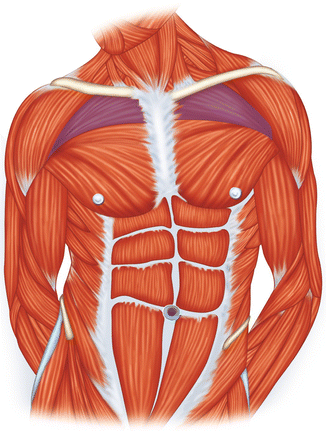
Fig. 32.31
Pectoralis major clavicular head
32.8.1.1 Anatomy
1.
Origin:
Clavicular part:
Anterior surface of the sternal 1/2 of the clavicle
2.
Insertion:
Muscle rotates before its insertion
Lower end of the lateral lip of the intertubercular sulcus of the humerus (3 laminae)
Anterior part: clavicular part
32.8.1.2 Functions
1.
Flexion
2.
Transverse adduction
3.
Internal rotation
4.
Adduction
5.
Abduction
32.8.1.3 Incline Push-up

Fig. 32.32
Incline push-up
1.
Lie prone by supporting the upper body to objects that have some height, with both arms on your shoulder width (Fig. 32.32a).
2.
Make your body straight, even when exercising remember to position your hips and legs in a straight line.
3.
While breathing in, continue to lower your arms before your chest touches the floor (Fig. 32.32b). Then pause for 1–2 s. Breathe out and extend your arms to return.
4.
When lowering your arms, elbows should point away from your body and exercise slowly from fully extended position.
5.
Give more resistance using a band. Exercise by coiling around your back and fix it with both hands.
6.
Patients with shoulder pain can exercise by externally rotating both hands 45° to lower resistance.
32.8.2 Sternal Head
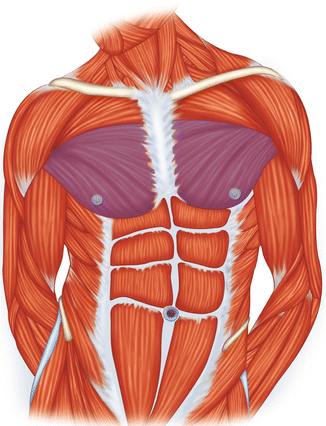
Fig. 32.34
Pectoralis major sternal head
32.8.2.1 Anatomy
1.
Origin:
Sternocostal parts
1/2 the breadth of the anterior surface of the sternum (cartilages of the 6th/7th ribs)
Cartilages of all the true ribs
2.
Insertion:
Muscle rotates before its insertion
Lower end of the lateral lip of the intertubercular sulcus of the humerus (3 laminae)
Middle part: upper sternocostal part
32.8.2.2 Functions
Shoulder:
1.
Flexion
2.
Transverse adduction
3.
Internal rotation
4.
Adduction
5.
Abduction
Scapula:
1.
Downward rotation



